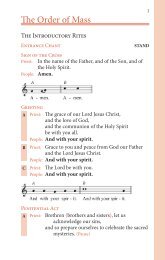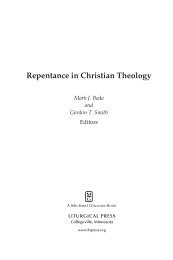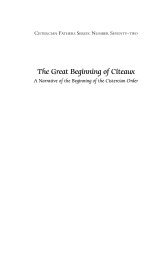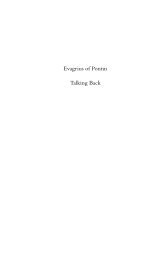“Fritz West, himself a methodological master of ... - Liturgical Press
“Fritz West, himself a methodological master of ... - Liturgical Press
“Fritz West, himself a methodological master of ... - Liturgical Press
You also want an ePaper? Increase the reach of your titles
YUMPU automatically turns print PDFs into web optimized ePapers that Google loves.
accuse another liturgical giant, Josef Andreas Jungmann, SJ (1899–<br />
1975), <strong>of</strong> disastrous assumptions without in any way detracting from<br />
the fact that Jungmann was one <strong>of</strong> the great liturgical scholars <strong>of</strong> all<br />
time. 8 The issue is not whether Baumstark or Dix or Jungmann were<br />
always right, but what we can derive from how they worked and from<br />
their liturgical insights.<br />
What we derive from them is a way <strong>of</strong> working and thinking that<br />
remains valid to the present day. Among liturgiologists, Anton Baumstark<br />
was one <strong>of</strong> the first to reflect <strong>methodological</strong>ly and critically on<br />
how he worked. In so doing, he provided a model for all practitioners<br />
<strong>of</strong> a science that, like any other scholarly discipline, needs not only<br />
objective research but also <strong>methodological</strong> reflection. Only via the<br />
endless process <strong>of</strong> sifting and resifting hermeneutical presuppositions<br />
through the sieve <strong>of</strong> shared critical reflection can scholars sharpen the<br />
tools <strong>of</strong> their craft and refine its methods via fruitful dialogue within<br />
the pr<strong>of</strong>ession. 9<br />
Liturgy is a living activity that can never, in Baumstark’s words, “be<br />
paralyzed into the rigour <strong>of</strong> an immobile dead formalism” (CL 1). By<br />
its very nature, liturgy is subject to a process <strong>of</strong> continuous evolution.<br />
The vocation <strong>of</strong> the historian <strong>of</strong> liturgy is “to investigate and describe<br />
the origins and variations <strong>of</strong> the changing forms <strong>of</strong> this enduring substance<br />
<strong>of</strong> eternal value” that is “the living heart <strong>of</strong> the Church” (CL 2).<br />
This means studying the evidence. And since the evidence presents<br />
similarities and differences, its study is perforce comparative. Were<br />
there no differences, there would be identity and nothing to compare<br />
or explain. Were there no similarities, there would be no basis for a<br />
comparative method to begin with. Those who would complain that<br />
this is to reduce to text what is per se a living action seem to forget that<br />
texts, along with archeological remains, are all <strong>of</strong> the distant liturgical<br />
past that remain to us.<br />
8 E. Duffy, “The Stripping <strong>of</strong> the Altars and the Liturgy: Some Reflections on<br />
a Modern Dilemma,” Antiphon: Publication <strong>of</strong> the Society for Catholic Liturgy, vol.<br />
1, no. 1 (Spring 1996): 2–3. Duffy, “The Stripping <strong>of</strong> the Altars and the Modern<br />
Liturgy,” Antiphon, vol. 2, no. 3 (Winter 1997): 3–12.<br />
9 For a superb recent example <strong>of</strong> such disciplinary reflection, see Harald<br />
Buchinger, “On the Origin and Development <strong>of</strong> the <strong>Liturgical</strong> Year: Tendencies,<br />
Results, and Desiderata <strong>of</strong> Heortological Research,” Studia Liturgica 40,<br />
nos. 1–2 (2010): 14–45.<br />
xviii






